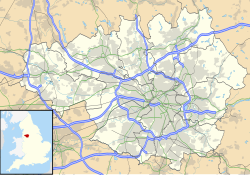Newton, Greater Manchester
 From Wikipedia - Reading time: 7 min
From Wikipedia - Reading time: 7 min
| Newton | |
|---|---|
 St Mary's Church, Newton | |
Location within Greater Manchester | |
| Metropolitan borough | |
| Metropolitan county | |
| Region | |
| Country | England |
| Sovereign state | United Kingdom |
| Post town | HYDE |
| Postcode district | SK14 |
| Dialling code | 0161 |
| Police | Greater Manchester |
| Fire | Greater Manchester |
| Ambulance | North West |
| UK Parliament | |
Newton is an area of Hyde, in the Tameside district, in Greater Manchester, England; it occupies a narrow strip of land from the River Tame, near Newton Hall, to Matley, between Hyde and Dukinfield.
Newton can be divided into four separate parts:
- Newton Green
- Flowery Field
- Newton Moor
- Newton
The former site of Shaw Hall factory lies on Matley Lane.
Governance
[edit]There is one main tier of local government covering Newton, at metropolitan borough level: Tameside Metropolitan Borough Council. The council is a member of the Greater Manchester Combined Authority, which is led by the directly-elected Mayor of Greater Manchester. The Hyde Newton electoral ward is named after Newton.[1]
For national elections, the Hyde Newton ward is part of the Stalybridge and Hyde constituency.[1]
Administrative history
[edit]Newton was historically a township in the ancient parish of Mottram-in-Longdendale, which formed part of the Macclesfield Hundred of Cheshire.[2][3] From the 17th century onwards, parishes were gradually given various civil functions under the poor laws, in addition to their original ecclesiastical functions. In some cases, including Mottram-in-Longdendale, the civil functions were exercised by each township separately rather than the parish as a whole. In 1866, the legal definition of 'parish' was changed to be the areas used for administering the poor laws, and so Newton became a civil parish.[4]
In terms of ecclesiastical parishes, Newton was separated from Mottram-in-Longdendale in 1841, following the construction of St Mary's Church the previous year.[5][6][7]
In 1871, the Newton township or civil parish was converted into a local government district, administered by an elected local board.[8] The district was also known as Newton Moor and was abolished just six years later in 1877, when the area was absorbed into the Hyde local government district.[9] The Hyde local government district was raised to the status of a municipal borough in 1881.[10]
Newton continued to exist as an urban parish within the borough of Hyde until 1923, when all the parishes within the borough were merged into a single civil parish called Hyde.[2][11] At the 1921 census (the last before the parish was abolished), Newton had a population of 7,715.[12]
The borough of Hyde was abolished in 1974 under the Local Government Act 1972. The area became part of the Metropolitan Borough of Tameside in Greater Manchester.[13]
Transport
[edit]
The area is served by two railway stations: Newton for Hyde and Flowery Field; both are stops on the Glossop Line between Manchester Piccadilly, Glossop and Hadfield. Services are operated by Northern Trains.[14]
The main bus route in the area is the 346, which links Hyde with Ashton-Under-Lyne; it is operated by Stagecoach Manchester.[15]
Education
[edit]Newton is served by the following primary and secondary schools:
- Bradley Green Primary School
- Flowery Field Primary School
- Oakfield Primary School
- St Paul's Catholic Primary & Nursery School
- Hyde Community College
Notable People
[edit]- Michael Barber (1934 - 1991), chemist and mass spectrometrist, best known for his invention of fast atom bombardment ionisation; born at 166 Lodge Lane in Newton
References
[edit]- ^ a b "Election Maps". Ordnance Survey. Retrieved 2 February 2025.
- ^ a b "Newton Township / Civil Parish". A Vision of Britain through Time. GB Historical GIS / University of Portsmouth. Retrieved 14 February 2025.
- ^ Book of Reference to the Plan of the Parish of Mottram-in-Longdendale. Ordnance Survey. 1874. Retrieved 14 February 2025.
- ^ Youngs, Frederic (1991). Guide to the Local Administrative Units of England: Volume II, Northern England. London: Royal Historical Society. p. xv. ISBN 0861931270.
- ^ "No. 20053". The London Gazette. 21 December 1841. p. 3291.
- ^ Historic England. "Church of St Mary (C of E) (Grade II) (1162405)". National Heritage List for England.
- ^ Kelly's Directory of Cheshire. 1914. p. 384. Retrieved 14 February 2025.
- ^ "No. 23777". The London Gazette. 19 September 1871. p. 3998.
- ^ "Local Government Board's Provisional Orders Confirmation (Hyde, &c.) Act 1877" (PDF). legislation.gov.uk. The National Archives. p. 3. Retrieved 14 February 2025.
- ^ "Hyde Municipal Borough". A Vision of Britain through Time. GB Historical GIS / University of Portsmouth. Retrieved 14 February 2025.
- ^ "Stockport Registration District". UKBMD. Retrieved 7 November 2024.
- ^ "Population statistics Newton Tn/CP through time". A Vision of Britain through Time. Retrieved 7 November 2024.
- ^ "Local Government Act 1972: Schedule 1", legislation.gov.uk, The National Archives, 1972 c. 70 (sch. 1), retrieved 15 January 2025
- ^ "Timetables and engineering information for travel with Northern". Northern Railway. 10 December 2023. Retrieved 31 March 2024.
- ^ "Newton Bus Services". Bus Times. 2024. Retrieved 30 March 2024.
 KSF
KSF